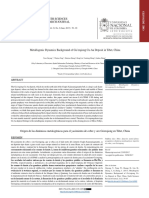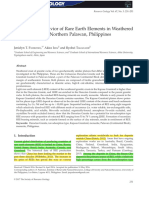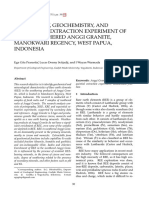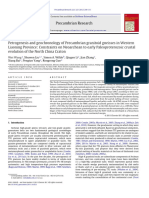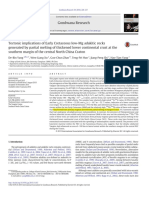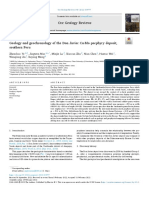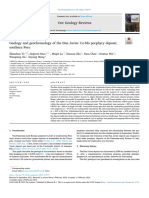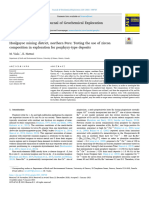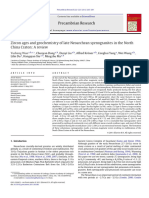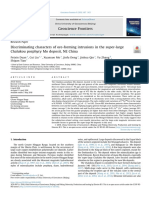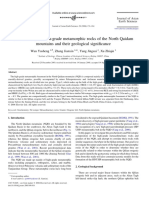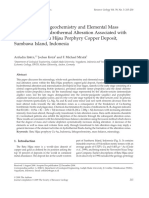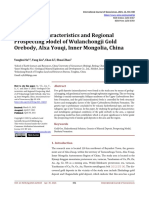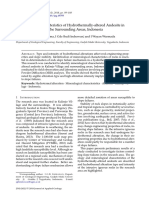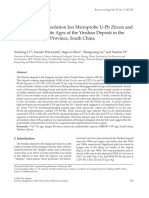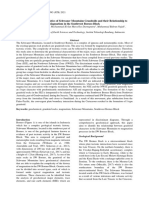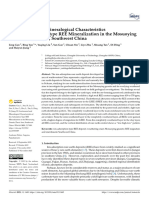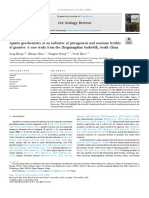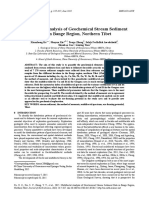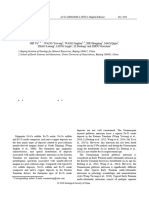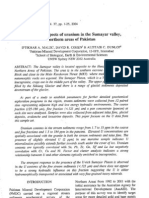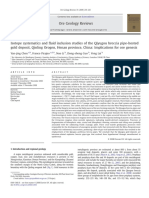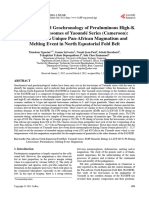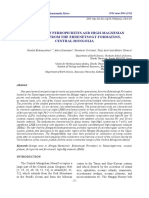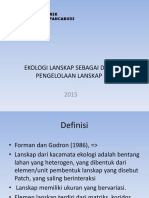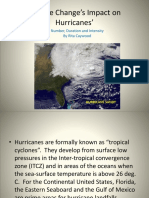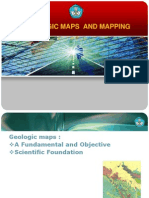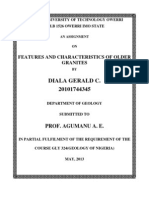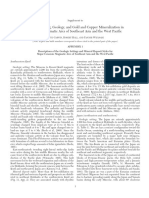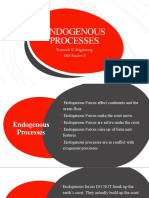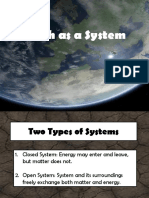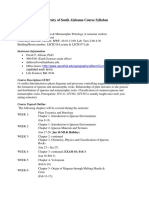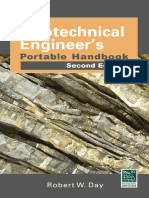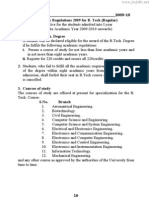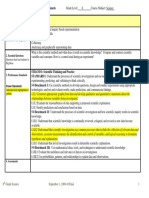Geochemical Evidence For K-Metasomatism Related To Uranium Enrichment in Daejeon Granitic Rocks Near The Central Ogcheon Metamorphic Belt, Korea
Geochemical Evidence For K-Metasomatism Related To Uranium Enrichment in Daejeon Granitic Rocks Near The Central Ogcheon Metamorphic Belt, Korea
Uploaded by
Taufiq Al IdrusCopyright:
Available Formats
Geochemical Evidence For K-Metasomatism Related To Uranium Enrichment in Daejeon Granitic Rocks Near The Central Ogcheon Metamorphic Belt, Korea
Geochemical Evidence For K-Metasomatism Related To Uranium Enrichment in Daejeon Granitic Rocks Near The Central Ogcheon Metamorphic Belt, Korea
Uploaded by
Taufiq Al IdrusOriginal Title
Copyright
Available Formats
Share this document
Did you find this document useful?
Is this content inappropriate?
Copyright:
Available Formats
Geochemical Evidence For K-Metasomatism Related To Uranium Enrichment in Daejeon Granitic Rocks Near The Central Ogcheon Metamorphic Belt, Korea
Geochemical Evidence For K-Metasomatism Related To Uranium Enrichment in Daejeon Granitic Rocks Near The Central Ogcheon Metamorphic Belt, Korea
Uploaded by
Taufiq Al IdrusCopyright:
Available Formats
GJ
Article
https://doi.org/10.1007/s12303-018-0053-9
pISSN 1226-4806 eISSN 1598-7477 Geosciences Journal
Geochemical evidence for K-metasomatism related to
uranium enrichment in Daejeon granitic rocks near
the central Ogcheon Metamorphic Belt, Korea
Jeong Hwang1 and Sang-Ho Moon2*
1
Department of Geotechnical Disaster Prevention Engineering, Daejeon University, Daejeon 34520, Republic of Korea
2
Geologic Environment Division, Korea Institute of Geoscience and Mineral Resources, Daejeon 34132, Republic of Korea
ABSTRACT: A new type of uranium occurrence in Korea was identified in pegmatitic and hydrothermally altered granite in the Dae-
jeon area. The U-bearing parts typically include muscovite, pink-feldspar and sericite as alteration minerals. In this study, the geo-
chemical characteristics and alteration age of the granitic rocks were examined to provide evidence for hydrothermally-enriched
uranium. The K-Ar ages of muscovite coexisting with U-bearing minerals were determined as 123 and 128 Ma. The U-bearing rocks
have relatively low (CaO + Na2O), high K2O contents, and high alteration index values by major element geochemistry. The trace ele-
ment geochemistry shows that the uraniferous rocks have significantly low Th/U ratios and strongly differentiated features. The rare
earth element patterns indicate that the uraniferous rocks have a low total REE and LREE contents with depletion of Eu. Considering
the geochemical variation of the granitic rock major, trace and rare earth elements, it can be concluded that uranium enrichment in
pegmatites and altered granite should be genetically related to post-magmatic hydrothermal alteration of K-metasomatism after
emplacement of the two-mica granite. This is the first report for geochemical characteristics of Mesozoic granite-related U-occurrences
in South Korea. This study will help further research for uranium deposits with similarities in geological setting, mineralogy and age
data between South China and Korea, and can also be expected to help solve the source problems related to high uranium concen-
trations in some groundwater occurring in the granitic terrane.
Key words: two-mica granite, uraniferous rock, geochemical characteristics, pegmatite, hydrothermal alteration, K-metasomatism
Manuscript received January 21, 2018; Manuscript accepted July 24, 2018
1. INTRODUCTION Cretaceous continental sedimentary were also reported in Korea
(Dahlkamp, 2009). However, recently, another type of uranium
The wide distribution of low-grade uranium (U) occurrences occurrence was first reported by Hwang et al. (2014). This was
has been reported in the meta-sedimentary rocks of the Ogcheon the first finding for U-occurrence spatiotemporally associated
metamorphic belt in central South Korea. These U-mineralized with Jurassic granitic rocks in Korea. These types of U-occurrences
zones are known to be coaly black shale type, and they are tens might be responsible for the highly elevated uranium concentration
of meters thick and hundreds of meters long. Their grade is up in some Korean groundwater.
to 0.11%, but there has not been any metal mining to date (Lee This study is focused on examining the geochemical
et al., 1986; Jeong, 2006). This type of uranium accumulation is characteristics related to the new U-occurrence in Korean
controlled by cyclic sedimentation and submarine hydrothermal Jurassic granitic rocks. The study area is located in the Daejeon
activity (Kim, 1989; Jo et al., 2013). Except for this black shale type, granitic region near the central Ogcheon metamorphic belt and
minor U-occurrences in Proterozoic metamorphic terrane and has been paid attention to for quite a while because of abnormally
high uranium concentrations in the groundwater. The dissolved
*Corresponding author: uranium in groundwater can originate from U-minerals or U-
Sang-Ho Moon
Geologic Environment Division, Korea Institute of Geoscience and Mineral
bearing accessory minerals in granite. Although close inspections
Resources, 124 Gwahak-ro, Yuseong-gu, Daejeon 34132, Republic of Korea of host rock geology and uranium content were continuously
Tel: +82-10-5455-6599, Fax: +82-42-868-3414, E-mail: msh@kigam.re.kr conducted (NIER and KIGAM, 2008, 2009), the exact U-bearing
The Association of Korean Geoscience Societies and Springer 2018 minerals and uraniferous host rocks responsible for groundwater
2 Jeong Hwang and Sang-Ho Moon
chemistry were not reported until 2014 (Hwang et al., 2014). grouped as age-unknown in this study (Fig. 1). Park et al. (1977)
Moon et al. (2013) reported that a great part of the U-mineralized reported that biotite granite and the two-mica granite have a
zone of the Ogcheon metamorphic belt near Daejeon might gradational boundary, and inferred that they had the same
have been assimilated into granitic melt during Mesozoic time, source of magma. So, the two granites are grouped into the
and suggested the necessity of determining the exact U-bearing same Jurassic granite body in this study. On the other hand, Lee
minerals in the granite body itself. In this respect, Hwang et al. et al. (1996) reported gneissose/schistose granites and biotite/
(2014) tried to find the uraniferous host rocks as the source of two-mica granites as Jurassic in age, but pink feldspar granite,
dissolved uranium in groundwater and finally reported the granophyre and quartz porphyry as Cretaceous in age, respectively,
occurrences of U-bearing minerals in the study area. based on age data from their own research and several other
The geochemistry of granite-related U-occurrence in Mesozoic references. Also, Kim et al. (2010) grouped the age-unknown
time has not been previously studied in Korea. The aim of this gneissose/schistose granites and biotite/two-mica granites into
study is to provide some geochemical evidence for the hydrothermal the single body of Jurassic biotite granites and reported two
uranium enrichment process in Jurassic granites from the Daejeon TIMS sphene U-Pb ages for the biotite granite occurring around
area, South Korea, especially with respect to the geochemical and in the Daejeon area as 174 Ma. Cheong and Kim (2012)
differences between barren and uraniferous granitic rocks. For reviewed previous age data for 98 sites of Phanerozoic granitoids
this purpose, the major, trace and rare earth element (REE) in the southern part of the Korean Peninsula and grouped the
geochemistry of the granitic rocks was examined and K-Ar age age-unknown gneissose/schistose granites and biotite/two-
dating was applied to alteration products. mica granites in this study area as Middle Jurassic (176~161 Ma)
granitoids in their geologic map. However, direct age data on
2. STUDY AREA gneissose/schistose granites in the study area have not been
reported.
2.1. Geological Setting The Jurassic granite occurs as leucocratic batholiths widely
intruded into the Precambrian rocks, Ogcheon group and age-
The geology in the study area consists of Precambrian unknown granite. Among them, the two-mica granite is the
metamorphic rocks, age-unknown Ogcheon meta-sedimentary most widely distributed in this area. Furthermore, two-mica
rock groups, and age-unknown and Mesozoic granite (Fig. 1). granite can also be seen partly within the age-unknown gneissose/
The granite-related U-occurrence can be found in the northern schistose granite body along the cutting plane of newly developed
part of Daejeon, which is tectonically situated in the central part roads (J5 and J6 in Fig. 1). In this case, some pegmatites and
of the Ogcheon metamorphic belt (OB in Fig. 1). altered parts occur along with the two-mica granite (P3, P4, P5,
The Precambrian metamorphic rock is dominated by mica- H4, and H5 in Fig. 1). The Rb/Sr whole rock age of two-mica
schist and granitic gneiss, which crops out in the northwestern granite occurring in the Daejeon area has been dated as 190 Ma
part of the study area. They can be found as xenoliths in the (Choo et al., 1982). Lee et al. (1980) reported that Jurassic granitic
Jurassic granite. Near the border with granite, mica-schist was magma in Korea was generated by crustal partial melting of
frequently intruded by pegmatite (Hwang et al., 2014). meta-sediments. The S-type feature is consistent with the field
The age-unknown Ogcheon meta-sedimentary rock groups observation that two-mica granite is occasionally associated
are developed in the southeastern part of study area and consist with relics of mica-schist. Park et al. (1977) also described the
of slate, phyllite and marble (Lee et al., 1996). A black shale layer pink feldspar granite, granophyre, and quartz porphyry as having
of 20–40 m thickness is intermittently found in these groups a co-magmatic origin based on their field textures and occurrences.
and has rich amounts of Ba, V, Mo and U (Jeong, 2006). The The Rb/Sr whole rock age of biotite granites (Muamsa granite,
Ogcheon groups were remarkably intruded by Jurassic granite Weolaksan granite, Sokrisan granite) from another area in the
in the southeastern part of the study area. Although there have Ogcheon Belt that has pink alkali feldspar (Yun et al., 2005) and
been several conflicting arguments regarding the age of the therefore can be correlated with the study area pink-feldspar
Ogcheon groups, most current studies report a Paleozoic age granite dated as 88 Ma to 94 Ma by Lee et al. (2010). The Cretaceous
(Choi et al., 2013). pink feldspar granite, granophyre and quartz porphyry occur as
Park et al. (1977) classified Daejeon granite into several rock stocks or dykes in the western side of the study area with shallow
units including age-unknown gneissose or schistose granite, intrusion features of micrographic and drusy structures (Park et
Mesozoic biotite or two-mica granite, pink feldspar granite and al., 1977; Lee et al., 1980). The Cretaceous granitic magma in
quartz porphyry. Gneissose or schistose granite occurs near the Korea is known to be of I-type mantle origin.
border with Precambrian rocks in the northwestern part and is
https://doi.org/10.1007/s12303-018-0053-9 http://www.springer.com/journal/12303
You might also like
- Geography Grade 8 Notes-1Document28 pagesGeography Grade 8 Notes-1kakozipascal267% (3)
- Answers: GeographyDocument9 pagesAnswers: Geographygaabo caliNo ratings yet
- Rocas CarbonatadasDocument12 pagesRocas CarbonatadasAldo YauriNo ratings yet
- Calagari AGG 2015 0001Document11 pagesCalagari AGG 2015 0001Sharrah Shelley E. LomigoNo ratings yet
- Lithos: Lan-Chun Huang, Shao-Yong JiangDocument20 pagesLithos: Lan-Chun Huang, Shao-Yong JiangNguyen tiendungNo ratings yet
- 1794 6190 Esrj 21 02 00059Document7 pages1794 6190 Esrj 21 02 00059smeykelNo ratings yet
- Geology, Geochemistry and Petrogenetic Studies of The Precambrian Basement Rocks Around Jimgbe, Northcentral NigeriaDocument12 pagesGeology, Geochemistry and Petrogenetic Studies of The Precambrian Basement Rocks Around Jimgbe, Northcentral NigeriaarkoesteaNo ratings yet
- Resource Geology - 2017 - PadronesDocument23 pagesResource Geology - 2017 - Padronesdanisse.casanovaNo ratings yet
- Mineralogy, Geochemistry, and Sequential Extraction Experiment of Ree in Weathered Anggi Granite, Manokwari Regency, West Papua, IndonesiaDocument12 pagesMineralogy, Geochemistry, and Sequential Extraction Experiment of Ree in Weathered Anggi Granite, Manokwari Regency, West Papua, IndonesiaRizal SulaimanNo ratings yet
- Petrogenesis and Geochronology of Precambrian Granitoid Gneisses - 2012 - PrecamDocument22 pagesPetrogenesis and Geochronology of Precambrian Granitoid Gneisses - 2012 - Precamombu.an93No ratings yet
- 2019 Zhao Et AlDocument23 pages2019 Zhao Et AlRavena VitóriaNo ratings yet
- Gondwana Research: De-Bin Yang, Wen-Liang Xu, Guo-Chun Zhao, Teng-Fei Huo, Jiang-Peng Shi, Hao-Tian YangDocument18 pagesGondwana Research: De-Bin Yang, Wen-Liang Xu, Guo-Chun Zhao, Teng-Fei Huo, Jiang-Peng Shi, Hao-Tian YangAckson KadiodoNo ratings yet
- Result and ConclusionDocument2 pagesResult and ConclusionMowassair HasanatNo ratings yet
- Ore Geology ReviewsDocument18 pagesOre Geology ReviewsJHONNY OMAR LAURA QUISPENo ratings yet
- 1 s2.0 S0169136822000853 Main 1 6Document6 pages1 s2.0 S0169136822000853 Main 1 6usccasoniaNo ratings yet
- Viala 2021Document12 pagesViala 2021AlexanderNo ratings yet
- Zinc-Lead Skarns of The Yeonhwa-Ulchin District, South Korea PDFDocument20 pagesZinc-Lead Skarns of The Yeonhwa-Ulchin District, South Korea PDFMartin NguyenNo ratings yet
- Vol 2 - Cont. J. Earth Sci 2Document24 pagesVol 2 - Cont. J. Earth Sci 2wilolud9822No ratings yet
- Ijg 2013012514573612Document20 pagesIjg 2013012514573612Lucas Pereira LeãoNo ratings yet
- Ojg 2023101915481705Document30 pagesOjg 2023101915481705ouedraogoNo ratings yet
- Zircon Ages and Geochemistry of Late Neoarchean Syenogranit - 2012 - PrecambrianDocument25 pagesZircon Ages and Geochemistry of Late Neoarchean Syenogranit - 2012 - Precambrianombu.an93No ratings yet
- Trazas en Circones en Porfiro de Cobre de ChinaDocument15 pagesTrazas en Circones en Porfiro de Cobre de ChinaEduardo ZappettiniNo ratings yet
- J Quaternary Science - 2021 - Yi - A Preliminary Study of Natural Environmental Change and Its Impact On Early LateDocument14 pagesJ Quaternary Science - 2021 - Yi - A Preliminary Study of Natural Environmental Change and Its Impact On Early LateRodrigo PaivaNo ratings yet
- Cao-2017-Marine and Petroleum GeologyDocument11 pagesCao-2017-Marine and Petroleum GeologyLicheng CaoNo ratings yet
- Geochemistry of High-Grade Metamorphic Rocks of THDocument11 pagesGeochemistry of High-Grade Metamorphic Rocks of THputriwahyuni947778No ratings yet
- Minerals 12 00967 With CoverDocument26 pagesMinerals 12 00967 With CoverPetros TemboNo ratings yet
- Geochronology and Geochemistry of The Shilu Cu-Mo Deposit in TheDocument17 pagesGeochronology and Geochemistry of The Shilu Cu-Mo Deposit in Thedarenwu114No ratings yet
- Exhumation of The Mesozoic Guojialing Granodiorite: Implication For The Preservation of Gold Deposits in The Jiaobei Terrane, ChinaDocument14 pagesExhumation of The Mesozoic Guojialing Granodiorite: Implication For The Preservation of Gold Deposits in The Jiaobei Terrane, ChinaAckson KadiodoNo ratings yet
- Resource Geology - 2009 - Idrus - Mineralogy Lithogeochemistry and Elemental Mass Balance of The Hydrothermal AlterationDocument16 pagesResource Geology - 2009 - Idrus - Mineralogy Lithogeochemistry and Elemental Mass Balance of The Hydrothermal Alterationangga.rajiman20No ratings yet
- 2023 Phyo Et Al Petrology Geothermobarometry and Geochemistry Mogok RocksDocument16 pages2023 Phyo Et Al Petrology Geothermobarometry and Geochemistry Mogok RocksMohamed MubassirNo ratings yet
- 1 PBDocument9 pages1 PBRaden AditNo ratings yet
- 2021 - Su Et Al. - Geological Characteristics and Regional Prospecting Model of Wulanchongji Gold Orebody, Alxa Youqi, Inner Mongolia, ChinaDocument8 pages2021 - Su Et Al. - Geological Characteristics and Regional Prospecting Model of Wulanchongji Gold Orebody, Alxa Youqi, Inner Mongolia, Chinabima pribadiNo ratings yet
- Mineralogical Characteristics of Hydrothermally-Altered Andesite in Kalirejo Village and The Surrounding Areas, IndonesiaDocument10 pagesMineralogical Characteristics of Hydrothermally-Altered Andesite in Kalirejo Village and The Surrounding Areas, IndonesiaReza AshariRNo ratings yet
- Xu 1999Document17 pagesXu 1999OmatoukNo ratings yet
- Early Mesozoic Crustal Evolution in The NW Segment of West QinlingDocument16 pagesEarly Mesozoic Crustal Evolution in The NW Segment of West Qinlingmantopangul56No ratings yet
- Resource Geology - 2007 - Li - Sensitive High Resolution Ion Microprobe U PB Zircon and 40ar 39ar Muscovite Ages of TheDocument13 pagesResource Geology - 2007 - Li - Sensitive High Resolution Ion Microprobe U PB Zircon and 40ar 39ar Muscovite Ages of Thedarenwu114No ratings yet
- Geochemical Characteristics of Schwaner MountainsDocument6 pagesGeochemical Characteristics of Schwaner MountainsirsyadrNo ratings yet
- Geochemical and Mineralogical Characteristics of IDocument17 pagesGeochemical and Mineralogical Characteristics of IErsarsit GeaNo ratings yet
- Adminjurnal,+02 Hal+167+-+176+ (Amirudin Granite+belt)Document10 pagesAdminjurnal,+02 Hal+167+-+176+ (Amirudin Granite+belt)Afifah DilasukmaNo ratings yet
- Apatite Geochemistry Zhang Et Al 2021Document15 pagesApatite Geochemistry Zhang Et Al 2021Marcos Henrique da CostaNo ratings yet
- (18547400 - Materials and Geoenvironment) Geochemical Assessment of Claystone Deposits From The Patti Formation, Southern Bida Basin, NigeriaDocument12 pages(18547400 - Materials and Geoenvironment) Geochemical Assessment of Claystone Deposits From The Patti Formation, Southern Bida Basin, NigeriaBelhadj Mohammed NafaaNo ratings yet
- Geoquimica de Alteraciones HidrotermalesDocument26 pagesGeoquimica de Alteraciones Hidrotermalesagvega69109No ratings yet
- Ke 2015Document11 pagesKe 2015OswaldoRoblesNo ratings yet
- Petrogenesis and Metallogenesis of The Niumaoquan Gabbroic Intrusion Associated With Fe-Ti Oxide Ores in The Eastern Tianshan NW ChinaDocument17 pagesPetrogenesis and Metallogenesis of The Niumaoquan Gabbroic Intrusion Associated With Fe-Ti Oxide Ores in The Eastern Tianshan NW ChinasolitudearlNo ratings yet
- Geochemical Aspects of Uranium in The Sumayar Valley, Northern Areas of PakistanDocument25 pagesGeochemical Aspects of Uranium in The Sumayar Valley, Northern Areas of PakistaniamalikNo ratings yet
- Protolith of Joko Tuo Marble Bayat CentrDocument5 pagesProtolith of Joko Tuo Marble Bayat CentrluthfiNo ratings yet
- Geochemical and Zircon U-Pb and HF Isotopic Study of The Baijuhuajian Metaluminous A-Type GraniteDocument17 pagesGeochemical and Zircon U-Pb and HF Isotopic Study of The Baijuhuajian Metaluminous A-Type GraniteLami NomanNo ratings yet
- Isotope Systematics and Fluid InclusionDocument17 pagesIsotope Systematics and Fluid InclusionJULIO CONDEZONo ratings yet
- YuanYe JESDocument12 pagesYuanYe JESbryanNo ratings yet
- Ojo+et+al. ILJS 163 189Document27 pagesOjo+et+al. ILJS 163 189asiama godsonNo ratings yet
- Ngnotue Et Al., 2012Document24 pagesNgnotue Et Al., 2012JiozangNo ratings yet
- Erdenetsogt FormationDocument12 pagesErdenetsogt FormationJavkhlanboldNo ratings yet
- Ilboudo Et Al 2015 Le Volcanisme Dans Les Series Birimiennes DuDocument23 pagesIlboudo Et Al 2015 Le Volcanisme Dans Les Series Birimiennes DunourtimalinNo ratings yet
- Geology, Alteration and Mineralization To Discover Pb-Zn-Cu in Manggar HillDocument8 pagesGeology, Alteration and Mineralization To Discover Pb-Zn-Cu in Manggar HillBayu PradanaNo ratings yet
- Park, J-W. Et Al. (2019)Document14 pagesPark, J-W. Et Al. (2019)WilliamsRafaelMataRimacNo ratings yet
- Post Orogenic Extension in The Eastern Part of The Jiangnan - 2012 - PrecambriaDocument20 pagesPost Orogenic Extension in The Eastern Part of The Jiangnan - 2012 - Precambriaombu.an93No ratings yet
- Ajol File Journals - 219 - Articles - 131964 - Submission - Proof - 131964 2605 355841 1 10 20160314Document19 pagesAjol File Journals - 219 - Articles - 131964 - Submission - Proof - 131964 2605 355841 1 10 20160314ADELEKEADEDOYINNo ratings yet
- Geology, Mineralogy, Geochem, PB, ZN, Ag Skarn DepositDocument30 pagesGeology, Mineralogy, Geochem, PB, ZN, Ag Skarn DepositBig GossanNo ratings yet
- Mesoarchaean Gold Mineralisation in The Barberton Greenstone Belt: A ReviewDocument14 pagesMesoarchaean Gold Mineralisation in The Barberton Greenstone Belt: A ReviewsKip9999No ratings yet
- Journal of Geochemical ExplorationDocument21 pagesJournal of Geochemical ExplorationjuanNo ratings yet
- Zheng 2015Document8 pagesZheng 2015daniel david araya tapiaNo ratings yet
- Introduction To Optical Mineralogy And Petrography - The Practical Methods Of Identifying Minerals In Thin Section With The Microscope And The Principles Involved In The Classification Of RocksFrom EverandIntroduction To Optical Mineralogy And Petrography - The Practical Methods Of Identifying Minerals In Thin Section With The Microscope And The Principles Involved In The Classification Of RocksRating: 3.5 out of 5 stars3.5/5 (2)
- Ground Water Exploitation - An IntroductionDocument20 pagesGround Water Exploitation - An IntroductionTaufiq Al IdrusNo ratings yet
- Preservasi Dan KonservasiDocument10 pagesPreservasi Dan KonservasiTaufiq Al IdrusNo ratings yet
- Climate Change - Hurric - CaywoodDocument15 pagesClimate Change - Hurric - CaywoodTaufiq Al IdrusNo ratings yet
- Oc 34 HTVDocument2 pagesOc 34 HTVTaufiq Al IdrusNo ratings yet
- Geologi Maping EdtDocument8 pagesGeologi Maping EdtTaufiq Al IdrusNo ratings yet
- Older GranitesDocument5 pagesOlder GranitesNkem Okonkwo50% (2)
- Garwin - Et - Al - 2005 Au-Cu Cenozoic Magmatic Arcs SE Asia-West Pacific - AppendixDocument32 pagesGarwin - Et - Al - 2005 Au-Cu Cenozoic Magmatic Arcs SE Asia-West Pacific - AppendixherryadiNo ratings yet
- Endogenous ProcessesDocument24 pagesEndogenous ProcessesRomnick MagdaraogNo ratings yet
- 1 - Introduction PDFDocument19 pages1 - Introduction PDFGirijesh PandeyNo ratings yet
- X Geo Minerals and Energy Resources Mod1 HandoutDocument7 pagesX Geo Minerals and Energy Resources Mod1 HandoutunknowncrewsubNo ratings yet
- Sandstone Copper Assessment of The Chu-Sarysu Basin, Central KazakhstanDocument74 pagesSandstone Copper Assessment of The Chu-Sarysu Basin, Central KazakhstanJHOEL_GEONo ratings yet
- Earth CyclesDocument44 pagesEarth Cyclesatif irshadNo ratings yet
- University of South Alabama Course SyllabusDocument6 pagesUniversity of South Alabama Course SyllabusconimelNo ratings yet
- Petroleum Geoscience: From Sedimentary Environments To Rock Physics - Second EditionDocument8 pagesPetroleum Geoscience: From Sedimentary Environments To Rock Physics - Second EditionAldair HidalgoNo ratings yet
- Department of Education: School Report On The Result of The Regional Mid-Year AssessmentDocument5 pagesDepartment of Education: School Report On The Result of The Regional Mid-Year AssessmentMARK JERALD MENDOZANo ratings yet
- Rock Water Interaction MarwaDocument15 pagesRock Water Interaction MarwaAlfonso UgarteNo ratings yet
- Geotechnical Engineering Portable Handbook by Robert W DatDocument36 pagesGeotechnical Engineering Portable Handbook by Robert W Datp8613947No ratings yet
- The Place of Faults in Petroleum Traps: Rasoul SorkhabiDocument32 pagesThe Place of Faults in Petroleum Traps: Rasoul Sorkhabic_b_umashankarNo ratings yet
- Science 2Document5 pagesScience 2abahyatemanNo ratings yet
- Mid Prediction TestDocument4 pagesMid Prediction TestJudefrianNo ratings yet
- Civil Engineering (Jntu R09) PDFDocument96 pagesCivil Engineering (Jntu R09) PDFKare ArchaneswarNo ratings yet
- SUMPADocument20 pagesSUMPAPrecious AcebucheNo ratings yet
- 6th Grade Science Curriculum MapDocument20 pages6th Grade Science Curriculum MapPerihan SayedNo ratings yet
- Geology of JharkhandDocument2 pagesGeology of Jharkhandmehtanamita80No ratings yet
- Floor Finishes and StonesDocument23 pagesFloor Finishes and StoneswqbdkjkqNo ratings yet
- Earth Science TQDocument4 pagesEarth Science TQWashima Bentulina SabtalNo ratings yet
- A Critical Analysis of Kylesku BridgeDocument10 pagesA Critical Analysis of Kylesku BridgeVeenoy DabeeNo ratings yet
- Rocks and Minerals For Grade 11Document2 pagesRocks and Minerals For Grade 11len100% (1)
- Igneous Petrology Andri's Lecture NoteDocument84 pagesIgneous Petrology Andri's Lecture Notesuryadi100% (2)
- SAC 101 - Course Material - 13.06.2023 - FinalDocument194 pagesSAC 101 - Course Material - 13.06.2023 - FinalRusho ArulrajNo ratings yet
- GeographyDocument10 pagesGeographyVijay KumarNo ratings yet
- GeologyDocument23 pagesGeologyjorge alamosNo ratings yet
- E Abstract GCGE2017Document99 pagesE Abstract GCGE2017kokong konengNo ratings yet





